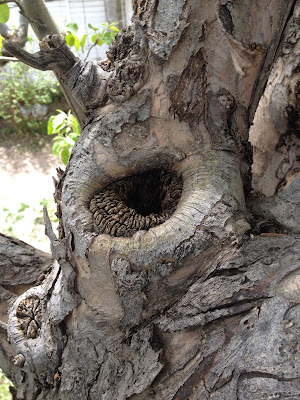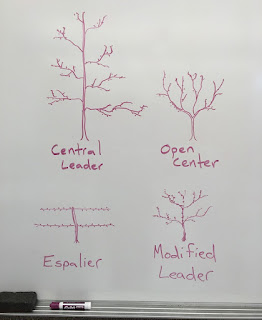6 Common Mistakes Gardeners Make When Pruning Fruit Trees
Gardeners Wait Too Long to Start Structural Pruning on Young Trees
Your fruit tree’s form and structure will allow it to hold heavy fruit loads and prevent broken branches. This form and structure is best established when your tree is still young. Corrective pruning on old mature fruit trees will increase stress on your tree and you will likely cause irreparable damage like heart wood rot. Starting your tree off right will significantly simplify tree maintenance and harvesting for the life of your tree.
 |
| Heart Wood Rot |
There are four common forms that can be used when pruning your fruit trees and deciding which form will work best for your tree should be done prior to your tree being planted. Consider what type of tree you will be planting and where your tree will grow in the landscape. Consider how much space your tree will have to grow. Some trees grow larger than others. Some trees will yield more fruit if pruned to work with their natural form rather than manipulating it to grow in an unnatural shape and direction.
 |
| Four Common Pruning Forms |
When shopping for new trees, look for and avoid structural problems that may weaken your tree as it matures. When young fruit trees have co-dominant leaders, they will develop included bark. Where included bark exists, your tree will be more likely to have broken branches. Wounds, breaks, disease, and other ailments in a young tree can affect its structural integrity as it matures.
 |
| Avoid Broken Branches |
If a fruit tree is left to grow too tall it will make it difficult to prune, spray, and harvest. Regular pruning will maintain an efficient height and prevent leggy branches like water sprouts shading out spurs.
 |
| Water Sprouts Shade Spurs |
Avoiding the mistake of not starting the pruning process when your fruit trees are young can prevent structural problems and simplify your maintenance for the life of the tree.
Gardeners Don’t Prune Often Enough
When is the best time to prune your fruit trees? The best time to do the bulk of your pruning is late winter/early spring, but pruning can be done any time of the year. If your tree has structural problems, or a contagious disease like Fire Blight that can be addressed by pruning, it is better to get it done now rather than waiting for spring. Pruning your fruit tree should be done at a minimum of once per year. Don’t let time of year scare you from making additional pruning cuts as needed.
 |
| Removing Fire Blight Should be Done Any Time of Year |
Gardeners Don't Prune Enough at Each Pruning
Pruning is voluntarily cutting and removing branches from your tree. Each cut leaves an open wound that exposes your tree to disease and other environmental stresses. It’s easy to let the fear of harming your tree prevent you from making necessary pruning cuts. Being conservative in your pruning will only increase the stress put on your tree later in its life. For example, If a branch needs to be removed, but you put off the pruning for another year the branch will have increased in size and girth. Each year the tree is left without pruning will only make each cut larger and more susceptible to long term damage and stress.
 |
| Allow some Light to Penetrate the Canopy |
Gardeners Prune Too Much at Each Pruning
I know, we just said that gardeners don’t prune enough out of their fruit trees, but the opposite is also common. I don't fully understand the root of this practice, but I think some people have been taught to prune trees this way.
I also think that there are gardeners who believe "some is good, more is better."
Trees collect light to produce sugar. The purpose of pruning is to help aid the trees ability to collect the light that it needs. If you prune too many branches from your tree, then you are allowing too much light to pass through the canopy. One way to tell if you have pruned the right amount from your tree is to wait until summer. When the tree is fully leafed out, look at the ground around your tree. How much light is touching the ground around your tree? If you see more sun than shade, then you probably pruned too much.
Gardeners Don’t Thin Fruit
Pruning fruit trees will help your trees to better support heavy fruit loads. When branches from a tree are removed it allows your fruit tree to put more energy to fruit production. The pruning will also allow light to enter the canopy so that any fruit set in the interior of your tree will grow to full maturity. Because of the increased energy and fewer aborted fruit, your tree will be at maximum capacity. This is good right? Well, you may find that the weight of the fruit exceeds your fruit tree’s ability to support that weight. If you have correctly pruned your tree and environmental factors are in your favor, then you will need to thin fruit from your tree.
 |
| Clusters Should be Thinned to One Fruit |
Gardeners Don’t Make Correct Pruning Cuts
Each branch that is removed from your fruit tree during pruning, should be done in such a way that it minimizes the stress on your tree. Large branches should be cut using the three cut method to avoid stripping bark from below the pruning cut. Cuts should be done as close to the collar as possible without damaging the ridge and collar. Larger cuts should be done perpendicular to the direction of growth. This will minimize the surface area of the cut to ensure that the collar seals off the wound in the shortest time possible. There is one exception to cutting branches perpendicular to the direction of growth. Branches growing vertically should be cut at a slight angle even if the surface area of that cut is larger than necessary. This prevents water from pooling on the heartwood as the wound heals. When tipping smaller branches, make the cut at a bud that is pointing in the direction that you want the tree to grow. Do not cut too close to the bud or leave too much of the internode.
 |
| Avoid Damaging the Collar |
Thanks for Reading! If you would like to learn more about the care and pruning of fruit trees, please browse our 100+ fruit tree articles here, join our Backyard Fruit Growers Facebook Group, and take our free Fruit Tree Pruning Course. Also, please subscribe to our Fruit Pruning YouTube Channel.



This is a well written article!
ReplyDeleteI was hoping to learn something new and I did.
Something to add:
If heavy pruning is done in early spring when the buds are full and fragile...
I find it useful to prevent cut branches from falling through the tree. If one holds on to a heavy branch with one hand while cutting, this branch can be carefully thrown out. If it is allowed to fall straight down many buds will get stripped off of the tree.
Thanks for the excellent tip Scott!
DeleteGood advice! Starting early and regularly is key!
ReplyDeleteI get many customers that have severely overgrown trees that take several years to get back into shape.
Thanks for the comment Abundant Design, LLC!
DeleteWonderful Content
ReplyDeleteThanks Eva!
Delete